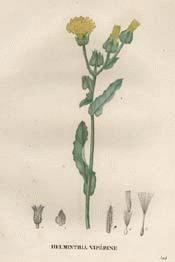
Botanical.com Home Page
Ox-TongueBotanical: Helminthia echioides---Part Used---Herb.
Closely allied to the Sow Thistles and somewhat resembling them in general appearance is the Bristly Ox Tongue (Helminthia echioides), frequently met with in England on hedgebanks and on waste ground, especially on clay soil, but less common in Ireland and rare in Scotland. ---Description---It is somewhat stout and coarse, the sturdy stems attaining a height of from 2 to 3 feet, branching freely and covered with short, stiff hairs, each of which springs from a raised spot and is hooked at the end. The lower leaves are much longer than the upper, of lanceolate or spear-head form, with their margins coarsely and irregularly toothed and waved. The upper leaves are small and stalkless, heart-shaped and clasping the stem with their bases. All the leaves are of a greyish-green hue and very tough to the touch. The flower-heads are ordinarily somewhat clustered together on short stalks and form an irregular, terminal mass at the ends of the main stems. The involucre, or ring of bracts from which the florets spring, is doubled outside the ring of eight to ten narrow and nearly erect scales, simple in form and thin in texture, is an outer ring composed of a smaller number of spiny bracts of a broad heart-shape, in their roughness of surface and general character resembling the leaves of the plant. The combination of the inner and outer bracts may be roughly compared to a cup and saucer, and gives the plant a singular appearance. The Ox Tongue is in blossom during June and July; all the florets of the flower-heads, as in the Dandelion, are of a rich golden yellow. The generic name, Helminthia, is Greek in origin and signifies a small kind of worm. It is suggested that the name was bestowed from the form of the fruit, but it seems more likely that the name may have been applied to the plant from some former belief in its power as a vermifuge. It has by some botanists been assigned to the genus Picris. The specific name, echioides, refers to the rough, prickly character of the stems and leaves. In spite of its spiny character, the Ox Tongue was used as a pot-herb in the same manner as the Sow Thistles, but can only be eaten when young, when it is said to have a pleasant taste. The juice is milky, bitter, but not extremely acrid. ---Other Species---
See (sow) THISTLE. [Top] © Copyright Protected 1995-2025 Botanical.com
|
